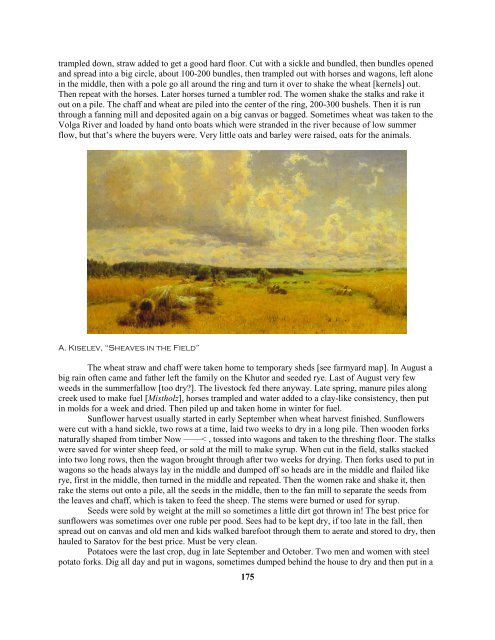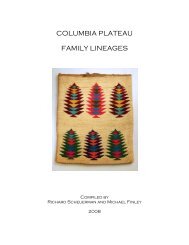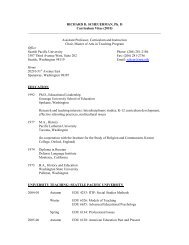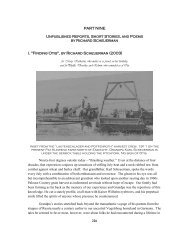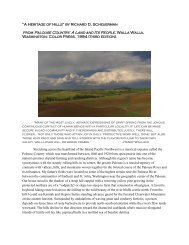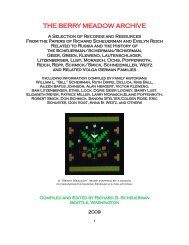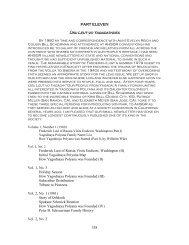PART SEVEN Oral Histories and Family Memoirs - Mountain Light ...
PART SEVEN Oral Histories and Family Memoirs - Mountain Light ...
PART SEVEN Oral Histories and Family Memoirs - Mountain Light ...
You also want an ePaper? Increase the reach of your titles
YUMPU automatically turns print PDFs into web optimized ePapers that Google loves.
trampled down, straw added to get a good hard floor. Cut with a sickle <strong>and</strong> bundled, then bundles opened<br />
<strong>and</strong> spread into a big circle, about 100-200 bundles, then trampled out with horses <strong>and</strong> wagons, left alone<br />
in the middle, then with a pole go all around the ring <strong>and</strong> turn it over to shake the wheat [kernels] out.<br />
Then repeat with the horses. Later horses turned a tumbler rod. The women shake the stalks <strong>and</strong> rake it<br />
out on a pile. The chaff <strong>and</strong> wheat are piled into the center of the ring, 200-300 bushels. Then it is run<br />
through a fanning mill <strong>and</strong> deposited again on a big canvas or bagged. Sometimes wheat was taken to the<br />
Volga River <strong>and</strong> loaded by h<strong>and</strong> onto boats which were str<strong>and</strong>ed in the river because of low summer<br />
flow, but that‟s where the buyers were. Very little oats <strong>and</strong> barley were raised, oats for the animals.<br />
A. Kiselev, “Sheaves in the Field”<br />
The wheat straw <strong>and</strong> chaff were taken home to temporary sheds [see farmyard map]. In August a<br />
big rain often came <strong>and</strong> father left the family on the Khutor <strong>and</strong> seeded rye. Last of August very few<br />
weeds in the summerfallow [too dry?]. The livestock fed there anyway. Late spring, manure piles along<br />
creek used to make fuel [Mistholz], horses trampled <strong>and</strong> water added to a clay-like consistency, then put<br />
in molds for a week <strong>and</strong> dried. Then piled up <strong>and</strong> taken home in winter for fuel.<br />
Sunflower harvest usually started in early September when wheat harvest finished. Sunflowers<br />
were cut with a h<strong>and</strong> sickle, two rows at a time, laid two weeks to dry in a long pile. Then wooden forks<br />
naturally shaped from timber Now ——< , tossed into wagons <strong>and</strong> taken to the threshing floor. The stalks<br />
were saved for winter sheep feed, or sold at the mill to make syrup. When cut in the field, stalks stacked<br />
into two long rows, then the wagon brought through after two weeks for drying. Then forks used to put in<br />
wagons so the heads always lay in the middle <strong>and</strong> dumped off so heads are in the middle <strong>and</strong> flailed like<br />
rye, first in the middle, then turned in the middle <strong>and</strong> repeated. Then the women rake <strong>and</strong> shake it, then<br />
rake the stems out onto a pile, all the seeds in the middle, then to the fan mill to separate the seeds from<br />
the leaves <strong>and</strong> chaff, which is taken to feed the sheep. The stems were burned or used for syrup.<br />
Seeds were sold by weight at the mill so sometimes a little dirt got thrown in! The best price for<br />
sunflowers was sometimes over one ruble per pood. Sees had to be kept dry, if too late in the fall, then<br />
spread out on canvas <strong>and</strong> old men <strong>and</strong> kids walked barefoot through them to aerate <strong>and</strong> stored to dry, then<br />
hauled to Saratov for the best price. Must be very clean.<br />
Potatoes were the last crop, dug in late September <strong>and</strong> October. Two men <strong>and</strong> women with steel<br />
potato forks. Dig all day <strong>and</strong> put in wagons, sometimes dumped behind the house to dry <strong>and</strong> then put in a<br />
175


